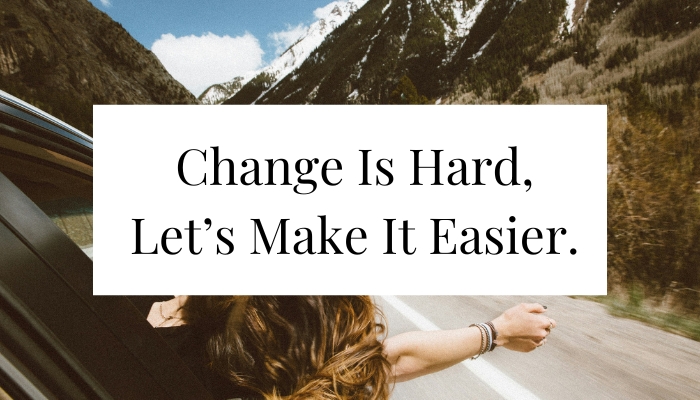Change is Hard. Here’s How You Can Make It Easier.
There’s no doubt that change is hard for all of us, big or small. We know it’s going to benefit our lives, but we still resist it. Why do we hesitate? What is it about moving forward and embracing change that seems so daunting?
The journey requires consistency, resilience, courage, and a desire for something better. Let’s look at why it feels so hard, and the steps you can take to move through your discomfort and come through the other side.
Why is it so Hard to Change?
Change is hard because we have to leave behind what feels familiar, comfortable, and secure. It’s not just about trying a new hobby or learning a new skill, it’s about transforming the very fabric of our being, our identity and, sometimes, the values we hold close to our hearts.
It requires us to step into the unknown, with complete faith in our ability to create a future different from our current reality.
There are a few culprits that may be sabotaging your best efforts. First, the resistance to change is deeply rooted in our psychological and biological makeup. Second, our approach can reduce our chances of success.
Why is Change So Hard – Psychology
Have you ever found yourself on the brink of something great, something that could potentially transform your life, yet something inexplicable holds you back? You’re not alone.
This hesitation is a common human experience, here’s why:
Your subconscious programming
This is something I know to be true, and I have seen it first hand in the work that I do with my clients. Countless clients have come to me with a desire to make a change, but they haven’t been able to, as time and time again they fell back into their old patterns.
Even when they received insights into what was going on internally and externally, it didn’t really change anything. The pattern just continued to play out. Anytime this happens, it’s subconsious.
I like to think of the subconscious mind as an old, grey doctor. You know those rigid doctors that are so set in their ways? They hardly listen to what you have to say, it’s the same prescription, the same treatment plan time and time again.
This is exactly like the subconscious mind. It’s job is to preserve life, just like a doctor’s job is. It will play out what it knows best, as it seeks safety, comfort, and familiarity. But, the good news is your subconscious can be changed!
However, in order to change it, we need to give it new instructions. It needs to go through a phase of unlearning and relearning, and it will only be open to this when it feels complete safety and all the past trauma and emotional baggage has been worked through.
New instructions mean new possibilities. New levels of love, wealth, impact, peace and happiness!

Habits and the Status Quo
Humans are creatures of habit. Habits create neural pathways that help us build routines and make decisions. When faced with changing a ‘bad habit’, you are effectively ‘rewiring’ your brain.
These pathways resist alteration, creating a ‘roadblock’ against new behaviors. This is why shedding old habits and forming new ways of thinking, feeling, and behaving can feel so difficult.
Feelings of Loss and Uncertainty
Emotionally, change is daunting because it requires letting go. Letting go of what’s familiar, even when the familiar is not good for us, evokes a sense of loss and uncertainty.
It’s not just about adjusting to new routines but also about redefining our identity and coping with our fear of failure. “What if I try something new, and it doesn’t work out?”, and “What I have now is fine, I should just be happy with where I am” are common thoughts that inhibit us from changing.
Our emotional attachment to the past is an anchor, that holds us where we are and makes the sail towards new horizons seem risky and unnecessary.
Cognitive Dissonance
Cognitive dissonance is the mental discomfort we experience when we hold two conflicting beliefs. For example, you might know that you need to end a relationship that isn’t serving you or making you happy, but the fear of ‘starting again’ or never finding your soulmate can block you from believing this is a good thing.
This conflict creates psychological discomfort, leading to resistance to protect yourself from experiencing any discomfort or pain.
Rather than viewing resistance as a barrier, see it as a sign. It highlights areas for deeper exploration of your fears, values, and motivations. Pause and reflect – what is the underlying fear here? While you might think the above example is a “fear of starting again or never finding your soulmate”, the true culprit is a deep fear of being alone.
Once you have identified the root fear, consider what could be causing this fear (for example, abandonment in childhood). Once we understand ourselves on a deeper level, we can begin to heal.
By acknowledging and understanding your resistance, you can address the underlying concerns, making your journey of change more conscious and less daunting.

How Your Approach To Change is Making it Harder
There are a few approaches to change that could be doing more harm than good. Here are some examples:
Your goal is Too Vague
If it’s too vague, it’s really hard for you to create lasting change. There are specific changes and milestones, such as “I want to leave my relationship as it is no longer serving me, and find the partner of my dreams”, and there are non-specific changes such as “I want to live a happier life”.
Wanting to live a happier life is a wonderful thing, but it doesn’t help you keep track of what you want to achieve and when, or what you want to let go of and leave behind. It also doesn’t give you a clear vision of what your future will look like, or what steps you must take to make this change.
You’re Changing Too Many Things At Once
Changing too many things at once can overwhelm you and leave you feeling like you’re fighting on all fronts. It also prevents you from focusing on the things most important to you, so even though it might be tempting to do everything in one go, it might actually delay the process.
Another reason why this sabotages your efforts is that if you feel like you’re ‘failing’ in one change, this can squash your motivation, increase impatience, and lead you to abandon your other goals.
When you’re seeking validation, internally or externally, that you’ve made the right decision, what you perceive as a failure could confirm your fears that you have made the wrong choice.
Focus on what’s most important to you, and give it your all.
One Change Involves Other Changes
Let’s use the previous example of leaving a relationship that is no longer serving you. While it might feel like you’re only changing one thing, it actually involves multiple changes at different stages of the process.
These are the unintended or underestimated ‘consequences’ of our decisions and require a lot of willpower and courage.
Leaving a relationship can trigger a relocation, a difficult financial situation if you don’t have much money, or even your daily routine. Being aware of and paying attention to the ‘consequence’ changes can help you prepare for the process.

How To Make Change Feel Easier
In this journey, many of us hit a wall, not because the goal isn’t clear, but because we haven’t fully explored our underlying motivations. This is known as our ‘why’. Exploring our motivations is more than a preliminary step; it’s a powerful catalyst for lasting change.
Aside from understanding our why, there are many steps we can take to make our process more effective and help ease the pain and discomfort that we’re experiencing.
The Power of Our ‘Why’
Our ‘Why’ is the foundation of our intentions, offering clarity when doubt clouds our vision. It’s the inner voice that reminds us of the larger purpose during difficult times.
Understanding this ‘Why’ goes beyond simply acknowledging it; it’s about connecting with the emotional and rational drivers that propel us forward.
Cultivate Your Mindset and Build an Emotional Connection
For change to be meaningful and sustainable, we must connect with it on an emotional level. It’s the difference between saying, “I want to improve my health”, and, “I deeply desire to live a long, happy, more fulfilling life with my loved ones”.
This emotional connection to your ‘Why’ makes change more compelling and our goals more attainable.
How To Identify Your Why
So, how do you identify your Why? It begins with introspection. Ask yourself what you truly want to achieve and why that goal is important.
Consider the deeper implications of the change on your life and the lives of those around you. Reflecting on these questions can help uncover a ‘Why’ that’s meaningful and motivating.
Reflect
Reflection helps you understand your Why.
Journaling, meditation, or conversations with trusted friends or professionals can help you discover your motivations and desires. These reflections can reveal patterns and themes, guiding you to a clearer understanding of your ‘Why.’

Connecting With Your Why
Once you have identified it, keep your Why at the forefront of your mind.
Visual reminders, such as sticky notes on the fridge or a lock screen image on your phone that encapsulates your reasons for change, can serve as daily motivators.
Additionally, continuously revisiting and reflecting on your Why on a daily basis can help you focus and adapt as you progress.
Strategies for Making It Easier
Change is going to challenge you, but it can feel less painful with the right strategies in place.
These methods, grounded in psychology and personal experience, help turn the daunting into the doable. Let’s explore how we can make this journey smoother and more approachable.
Set Clear, Achievable Goals
Setting SMART goals is a powerful approach to making significant changes in your life, giving you the clarity you need to move forward with confidence. SMART goals are Specific, Measurable, Achievable, Relevant, and Time-bound.
Let’s look at setting SMART goals, using the previous example of leaving a relationship. Here’s how you can apply this framework to this sensitive and personal decision:
- SPECIFIC – Your goal should be clear and specific. Instead of saying, “I want to leave this relationship,” define what that means for you. For example, “I want to end my current relationship by the end of the month because it no longer contributes to my personal growth and happiness.”
- MEASURABLE – Identify what success looks like. How will you know that you’ve achieved your goal? In this context, it could be, “I will have successfully moved out and started living independently, maintaining a healthy emotional state throughout the process.”
- ACHIEVABLE – Ensure your goal is realistic and attainable. Do you have the resources and capabilities to achieve it? If not, what are you missing, and how can you get it? For instance, “I will seek emotional support from friends and a professional, and ensure I have a stable financial plan to support my independence.”
- RELEVANT – Your goal should align with your broader life goals. Ask yourself if this is the right time and if it’s truly important to you. For example, “Leaving this relationship is relevant to my long-term happiness and health, and aligns with my goal of finding a supportive and loving partner.”
- TIME-BOUND – Set a realistic deadline. Having a target date motivates you to take action. For instance, “I will have a conversation with my partner about ending the relationship within the next month, and plan to move out within three months.”

Create a Supportive Environment
Change rarely happens in isolation. Creating an environment that supports your goals might mean surrounding yourself with people who encourage and motivate you, seeking out mentors who have navigated similar changes, or even altering your physical space to reduce temptations.
Persistence is Key
As humans are creatures of habit, create a routine that will turn something that requires extreme mental effort into something that becomes automatic. Identify key habits that support your goals and integrate them into your daily routine.
For example, if your goal involves fitness, consider setting a specific time each day for exercise. Over time, this activity will require less mental effort to initiate.
Mindfulness and Self-Compassion
Setbacks and challenges are inevitable, so practicing mindfulness and self-compassion during these times is crucial. Mindfulness keeps you present and focused, and self-compassion means treating yourself with kindness during setbacks.
Change is hard at first and messy in the middle, so understanding that progress is not linear, and that every step, forward or backward, is part of the journey.
Visualize Your Success
Visualization is a powerful tool. Even if you don’t have much time, set aside 5 minutes every night to visualize achieving your goals, and allow yourself to experience the feelings associated with your success.
This practice will help you stay motivated and will prepare your mind to recognize and seize opportunities when they present themselves.

Reward Progress
Recognizing and rewarding progress, no matter how big or small, can help you sustain your motivation. Set smaller milestones within your larger goal and celebrate when you reach them.
These rewards can be as simple as taking a moment to acknowledge how far you’ve come, or doing one of your favorite activities.
My Personal Experience with Change
I was inspired to write this blog post following a story I have been frequently sharing with my clients.
Recently, I started back at the gym. I had hit rock bottom with my body image, so I decided it was time to make a change. I finally was ready to overcome all the excuses that I let stop me for the past three years.
My first session back felt weird, but overall I felt good and proud of myself for going. That was until the next day, when I woke up in the morning feeling stiff, sore, and rundown. I took a day off to recover, and I went back to the gym again the following day.
I did the exact same workout, but I couldn’t lift as much weight as my first session. My muscles hadn’t recovered, and the internal struggle was real. I didn’t feel as good or as proud of myself this time round.
My journey over the following months was emotionally turbulent. Sometimes I loved it, and sometimes I didn’t. Some days I pushed myself too far, and others I didn’t push myself enough. It took months of conditioning for my body to get to a place where it was used used to this pressure.
But of course, once I had reached this phase, I wanted more. I had reached my mountain, so I started lifting heavier weights doing an extra round, and here I was again feeling sore I pushed myself over my limit and had to take extended rest.

Here is what I learned – change is easy when you get instant reward or gratification. But, when that gratification is delayed OR it brings you more challenge, uncertainty, pain, and discomfort – it can be really hard to keep showing up for yourself.
My journey with the gym is like any other change. Quite often, our desire and commitment to change comes from hitting rock bottom.
The journey is rarely a straight path, and it’s likely that two or more parts of you will have a tug of war inside your mind, like having a devil and an angel sat on your shoulder, whispering into each ear.
My personal experience has taught me that the most profound thing you can do for yourself in committing to change is building momentum through consistent action until it becomes a habit, celebrating your small wins everyday, remembering your WHY – especially when a part of you tries to convince you to quit.
Tools and Resources to Support You
Equipping yourself with the right tools and resources can make all the difference:
Mindfulness and Meditation Resources
Mindfulness and meditation have proven benefits in managing stress and enhancing focus—two critical aspects when dealing with change.
Explore guided meditation apps, online mindfulness courses, or local meditation groups that can teach you techniques to stay present and resilient. I have several meditation videos over on my YouTube channel:
Support Groups and Coaching
Having a supportive community or a coach can make your journey easier. Lean on friends, and look out for online forums, local meetups, or professional coaching services that focus on the type of change you’re pursuing.
Sharing experiences and receiving guidance from others who have navigated similar paths can provide both comfort and actionable advice.
Why Change Is Hard: Final Thoughts
Anything that’s hard to change is being propped up by a subconscious safety mechanism. An habitual, rigid and predetermined way of thinking, feeling and behaving.
Changing the subconscious involves processing your past by working through the life events, challenges and wounds that created these programs.
Once your past has been effectively process and the emotional baggage has been released your subconscious will then be open to new instructions.
The path is not linear but is a spiral of learning, growing, and evolving. Each step forward brings you closer to your desires, enriching your life with new experiences and opportunities.
Remember, change is not just about reaching a destination but about the journey and the person you become along the way.
Are You Ready to Embark on a Journey of Change and Self-Improvement?
The journey of change and self-improvement requires courage, support, and a deep commitment to personal growth. It’s a transformative process that can lead to the life you’ve always imagined.
I will support you in moving through this challenging process, and give you the tools to achieve your goals and open your heart to your endless potential. If this sounds like something you need, then now is the time to take the first step:
The Empowered Woman Program
Rooted in building Self-Leadership, The Empowered Woman Program will give you the tools to develop the profound ability to understand yourself and curate your dream life, beyond past wounds and protective mechanisms.
Guided by a heart-centered, no-nonsense approach, the program involves pragmatic coaching, heart-centered therapy, skill-building, and self-directed learning.







